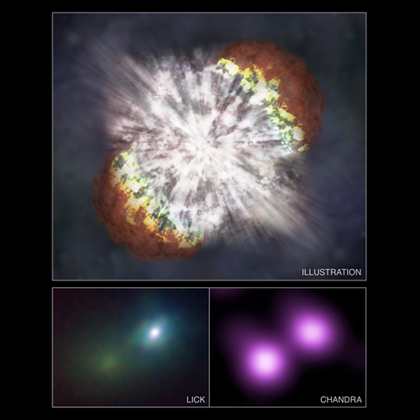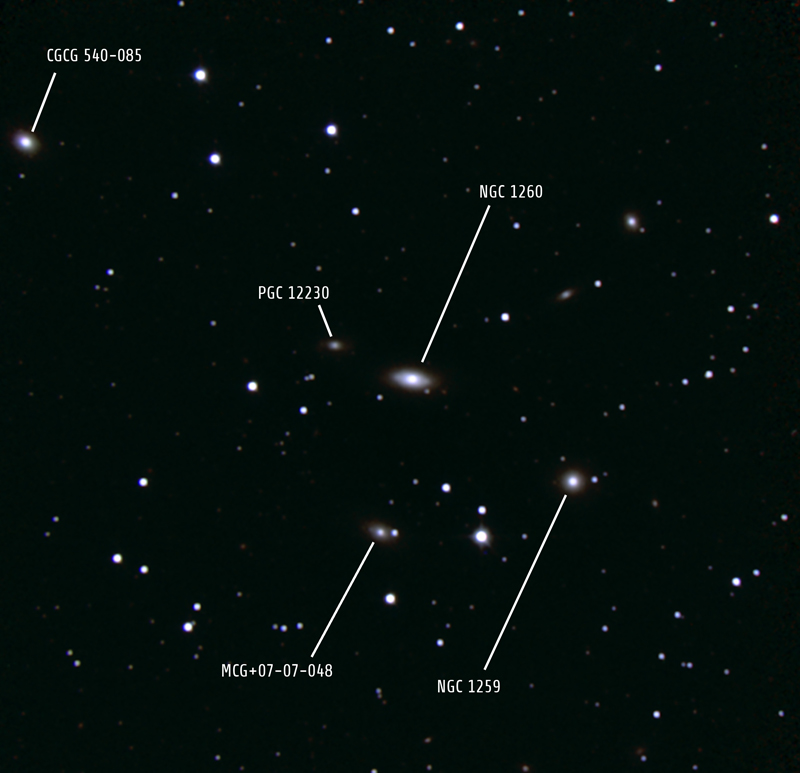The brightest stellar explosion ever recorded may be a long-sought new type of supernova, according to observations by NASA's Chandra X-ray Observatory and ground-based optical telescopes. This discovery indicates that violent explosions of extremely massive stars were relatively common in the early universe, and that a similar explosion may be ready to go off in our own Galaxy. Credit: Illustration: NASA/CXC/M.Weiss; X-ray: NASA/CXC/UC Berkeley/N.Smith et al.; IR: Lick/UC Berkeley/J.Bloom & C.Hansen
Credit: Illustration: NASA/CXC/M.Weiss; X-ray: NASA/CXC/UC Berkeley/N.Smith et al.; IR: Lick/UC Berkeley/J.Bloom & C.Hansen
"This was a truly monstrous explosion, a hundred times more energetic than a typical supernova," said Nathan Smith of the University of California at Berkeley, who led a team of astronomers from California and the University of Texas. "That means the star that exploded might have been as massive as a star can get, about 150 times that of our Sun. We've never seen that before."
Astronomers think many of the first generation of stars were this massive, and, therefore, this new supernova may provide a rare glimpse of how the first stars died. It is unprecedented, however, to find such a massive star and witness its death in the local Universe. The discovery of the supernova, known as SN 2006gy, provides evidence that the death of such massive stars is fundamentally different from theoretical predictions. SN 2006gy is the brightest stellar explosion ever recorded and may be a long-sought new type of supernova, according to observations by NASA's Chandra X-ray Observatory and ground-based optical telescopes. This discovery indicates that violent explosions of extremely massive stars were relatively common in the early universe. These data also suggest that a similar explosion may be ready to go off in our own Galaxy.(Credit: NASA/CXC/UC Berkeley/N.Smith et al.)
SN 2006gy is the brightest stellar explosion ever recorded and may be a long-sought new type of supernova, according to observations by NASA's Chandra X-ray Observatory and ground-based optical telescopes. This discovery indicates that violent explosions of extremely massive stars were relatively common in the early universe. These data also suggest that a similar explosion may be ready to go off in our own Galaxy.(Credit: NASA/CXC/UC Berkeley/N.Smith et al.)
"Of all exploding stars ever observed, this was the king," said Alex Filippenko, leader of the ground-based observations at the Lick Observatory in California and the Keck Observatory in Hawaii. "We were astonished to see how bright it got, and how long it lasted."
The Chandra observation allowed the team to rule out the most likely alternative explanation for the supernova, namely that it was an explosion of a white dwarf star with a mass only slightly higher than the Sun into a dense, hydrogen-rich environment. In that event, SN 2006gy should have been 1,000 times brighter in X-rays than what Chandra detected.
"This provides strong evidence that SN 2006gy was, in fact, the death of an extremely massive star," said Dave Pooley of U.C. Berkeley who led the Chandra observations.
The star that produced SN 2006gy apparently expelled a large amount of mass prior to exploding. This eruption is similar to one seen from Eta Carinae, a massive star in our Galaxy, raising suspicion that Eta Carinae may be poised to explode as a supernova. Although SN 2006gy is intrinsically the brightest supernova ever, it is in the galaxy NGC 1260 some 240 million light years away. However, Eta Carinae is only about 7500 light years away in our own Milky Way galaxy.
"We don't know for sure if Eta Carinae will explode soon, but we had better keep a close eye on it just in case," said Mario Livio of the Space Telescope Science Institute in Baltimore, who was not involved in the research. "Eta Carinae's explosion could be the best star-show in the history of modern civilization."
Supernovas usually occur when massive stars exhaust their fuel and collapse under their own gravity. In this case of SN 2006gy, astronomers think that a very different effect may have triggered the explosion. Under some conditions, the core of a massive star produces so much gamma-ray light that some of the energy from the radiation is converted into particle and anti-particle pairs. The resulting drop in energy causes the star to collapse under its own huge gravity.
After this violent collapse, runaway thermonuclear reactions ensue and the star explodes, spewing the remains into space. The SN 2006gy data suggest that spectacular supernovas from the first stars -- rather than complete collapse to a black hole -- may be more common than previously believed. This image is a wide-field infrared view from the PAIRITEL telescope of the galaxy NGC 1260. NGC 1260 is located about 240 million light years away. (Credit: PAIRITEL/UC Berkeley/J.Bloom)
This image is a wide-field infrared view from the PAIRITEL telescope of the galaxy NGC 1260. NGC 1260 is located about 240 million light years away. (Credit: PAIRITEL/UC Berkeley/J.Bloom)
"In terms of the effect on the early Universe, there's a huge difference between these two possibilities," said Smith. "One pollutes the galaxy with large quantities of newly made elements and the other locks them up forever in a black hole."